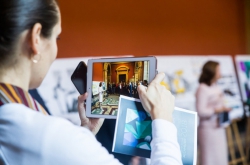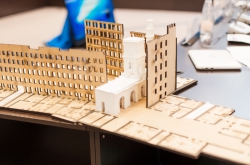Data has long become something global that unites whole countries. Oftentimes, if there's no information of some event or object on the Internet, we just don't believe it exists. Data traffic grows with each year, so now, artists and programmers aspire to create a new language for it by combining art and science.
Big Data has long become a field not only professionals are engaged in - as of now, common people also take part in analyzing it. In 2010, London city authorities opened access to governmental agencies' basic data to citizens. The information was on processes in the city's economic, traffic systems and such, and was updated in real-time mode. By using it, anyone could generate particular reguarities or just monitor the processes he or she was interested in. As of now, many countries support the idea of publishing open government data on the Internet.
Almost everyone uses devices that allow us to interact using data, and gadgets are now becoming art tools. For instance, The RadarCat project uses Google's Soli chip to identify materials and objects by "feeling" them like we do with our hands.
 A shot from the film "X-men" Credit: tehnot.com
A shot from the film "X-men" Credit: tehnot.com
Mind-reading is one of the things sci-fi writers like to write about; surely, we cannot yet "read" one another's thoughts, but modern neural interfaces can already tell a person's mood, and can be used in visualizing it. The Neurointegrum performance staged at the New Stage of Alexandrinsky Theatre by Yuri Didevich in 2015 presented the actors thoughts as sounds and images on a big screen behind her.
Data can also be used for self-identification. Algorithms trace our every move; almost any interaction with digital technologies generates new data. Each photo, message or geo tag become part of one's digital portrait. For example, data artist Laurie Frick uses GPS-tracks to create "data-selfies" using her FRICKbits program.
The Listening to Wikipedia project is something like a musical performance that visualizes the open encyclopedia's content: it is a peculiar "map" that reflects the recent changes in real-time mode.
The Google DeepDream project is a good example of how AI algorithms become an artistic tool. Initially, the program was created to help scientists and engineers understand what a neural network “sees” when they show it an image. Later, the project was used for creating abstract or psychedelic art.
Another example of an art project on data visualization is Liquid~Do - an interactive experiment on representing data from chemical reactions. The artist added colourants and a special compound to milk, thus inducing a chemical reaction. A computer program traced the changes in color and processed them into data that was then used by a synthesizer to play sounds.
 Dmitriy Muromtsev
Dmitriy Muromtsev
Black Shoals is a project based on data from the stock market's activity. The viewer sees it as some kind of anorrery: a night sky full of "stars" that shine brighter when deals are made.
The Kaleidoscope project's authors tried to represent the overall amount of data one consumes by developing a map that works in real-time mode and represents the recent news publications. Each of its elements is a news piece or a hashtag.
A similar idea is used for CIDOC CRM - ontology for documenting and exchanging data that has to do with cultural heritage.
Julia Freeman, an artist who works with data, and a group of experts completed the Lake project in 2005; the project gives data on fish that live in a certain lake in rural area. They caught and tagged 16 fish from the thousands that swim in the lake.
"We had a physician in our team who tagged the fish; the whole procedure was to take no more than two minutes, or they would've died. We used bio-acoustic tags with a quiet signal, then fixed six hydrophones on the lake's shores and used them to trace them. When we put the fish back into the lake, we could see them on the monitor," shares Julia Freeman.
 Julia Freeman
Julia Freeman
The experts got different information from this experiment - places where the fish swim, as well as some regularities in their behavior: some gathered in groups, some preferred being alone. Most scientists won't be interested in studying such subjective characteristics, yet artists are.
The project was presented not in some museum, but in a tower close to the lake. Upon entering the tower, a person got into the "digital lake": the visualized data is broadcasted on a large display above one’s head, in real time mode, 24/7. Among the first visitors to the tower were local fishermen who wanted to see where the fish are. Despite the fact that only 16 of the fish were tagged, people were under impression that they can receive data on everything that happens in the lake.
"From this project, we've learned that gathering data is an important part of our work. And, surely, we have to clearly understand why do we collect this data. All processes are based on one's decision, so we have to keep in mind why do we collect particular data and how are we going to present it to the public," comments the artist.
 Mole-rat. Credit: hqplace.ru
Mole-rat. Credit: hqplace.ru
The project Julia works on at the moment is for studying biological data in real-time mode, as well. This time, she and her team study mole-rats. These creatures are of interest from the genetics point of view: they live for about 30 years, which is by ten times more than the average lifespan of mammals of their size, they are good at enduring pain and can live underground. Also, mole-rats are of the few mammals that exhibit eusocial tendencies - they live in a community similar to how bees and ants do; another of their traits is resistance to cancer. Mole-rats live in colonies and are great at surviving.
"We've planted the systems that allow us to monitor mole-rats' lives 24/7. We have an artificial colony where they live, we've tagged them as we did with fish and can always tell where they are. This way, we can study these creatures a lot better. Earlier on, scientists tried to study them in daylight, yet mole-rats live in darkness. Using our systems, we can now monitor their behavior in natural surroundings," explains Julia Freeman.

One can watch the mole-rats' movements on the project's website.
The data from the project is used for both scientific purposes and as artistic material. The abstract artwork "A Selfless Society" reflects the mole-rats' selflessness and how they live and help each other in their community.
During the project on studying mole-rats, the experts became interested in the idea of how can one represent data as a physical object, not just by using sounds or visualizing it on some display. They found a solution in Robotics. Their idea is to find a new language for expressing what's happening to an object: for instance, the shadow from a lamp can tell of its condition (like it will soon burn out and such). The "Nature Now" project is three objects - cylinders that reflect the movements of three mole-rats. Depending on the data they receive, they can change their shape. Surely, this is not some direct information on the animals' behavior, but it reflects their life as a community; in essence, this is what can be called the face of data.





